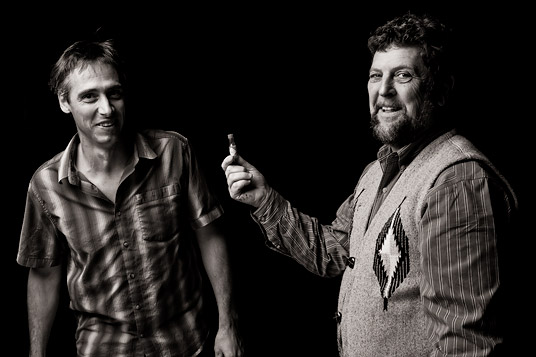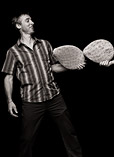
Gary Paul Nabhan & Josh Tewksbury
A predictive science
THEMES: Science & Research, Definitions | WORKSHOP: Natural History & Society
Biographies
Gary Paul Nabhan
Gary Paul Nabhan grew up in the Indiana Dunes under the influence of his Lebanese relatives and great naturalists such as Henry Cowles, Donald Culross Peattie and Edwin Way Teale, and did his first "wilderness solo" there at the age of sixteen. After dropping out of high school and working at the Environmental Action national headquarters for the first Earth Day, he went West to Prescott College. It was there that he fell in love with both field biology and narrative natural history. He went on to the University of Arizona for a masters in agricultural botany and a PhD in arid lands resources, simultaneously working in ethnobiology, nature writing and conservation biology. He has published twenty-four books ranging from The Forgotten Pollinators to The Geography of Childhood to Coming Home to Eat. Nabhan currently lives in Patagonia, Arizona where he is involved in collaborative conservation of working landscapes, nectar corridor restoration for migratory pollinators, and genetic resource conservation of native and Mission-era Spanish and Arab food crops.Conversations:
- An act of creativity
- A predictive science
- Binoculars of our age
- On the railroad with binoculars
- Sky dance
- Packrats
Workshops:
Josh Tewksbury
Josh grew up on farms, went to a high-school with a 3,000 acre campus composed mostly of oak trees, and spent his undergraduate career learning natural history at Prescott College, focusing on butterflies, plants and birds. Studies of birds sustained him through graduate school in Montana, and his inability to stop looking at plants (in particular, chili peppers) led him through a couple of post-docs and on to the University of Washington. He has been there since, working primarily on interactions between plants, animals, and their environment. He is an ecologist, a naturalist, and a conservation biologist; co-founder and board member of the Natural History Network, co-director of the Ecology of Bird Loss Project, and founder and chair of the natural history section at the Ecological Society of America. His research centers on the study of mechanism, process and context, and has spanned studies of fragmentation, connectivity, climate change, food security, and the consequences of lost mutualisms.Conversations:
- A predictive science
- Binoculars of our age
- The first human endeavor
- Ten thousand pictures
- An exciting time to be a naturalist
Workshops:
Transcript
Josh Tewksbury: When you somehow convinced me that it was okay to work an entire summer for your food in Mexico, and maybe you'd help pay for the gas of a truck...
Gary Paul Nabhan: We didn't pay for all the tires you went though that summer.
Josh Tewksbury: No, we had to pay for those!
That was it. That formative experience of crawling underneath an ironwood tree and counting small twigs and being able to say, "That dead twig? I know that species. I know that it's only here, and then here and then here." And there's the pattern developing. Getting so you can read that landscape, that small landscape, and then the larger one from that. I think that was the first pivotal moment that I realized I love this thorny, hot, sticky landscape.
Gary Paul Nabhan: You know you're saying something important there. As you accumulate these observations the joy of it then becomes the pattern recognition. So that after five or ten years of studying wild beans and chilies, I'd be driving along a road in Mexico or hiking a trail, and something would flash, a gestalt, a sense in my body. I'm going to see a wild bean or a wild chili within the next hundred yards. Because the pattern was there in front of me, and it was predictive, it wasn't just descriptive.
Josh Tewksbury: I do the same thing in Bolivia searching for chilies. You can't describe why you know there's going to be a chili nearby, necessarily, but it works.
Gary Paul Nabhan: And that is embodying natural history. We use the word history in natural history without thinking about it, but you accumulate this history of observations that then informs what you're seeing. There's a feedback loop between what you've seen, or smelled or heard in the past – bird calls, the fragrances of flowers – that then informs and helps you anticipate whats before you as you go into a new experience. I think that's pretty exciting.
Josh Tewksbury: So the history of natural history is the fact that it's a process and a discipline that is accumulated over time in your experience with a place. It has to have a history for it to work.
Gary Paul Nabhan: That's right.
Josh Tewksbury: That's what makes it natural history. Not so much that you're looking back in time, but you're looking back through your own experience, and those experiences allow you to make natural history a predictive science in some cases.
Gary Paul Nabhan: That's right. What I love about that, too, is that we build on a culture of naturalists before us. One of the most exciting moments I've ever had in a library was looking at the notes of Padre Francisco Garcés – one of the first missionaries that came up through this country where we're having this meeting on the U.S.-Mexico border – and to see his handwriting describing a place that I was in two centuries later was fantastic. Because some of the same plants were there and I knew the names not only in Latin and English, but in Spanish. I could literally begin to see images, just reading this notebook from two centuries before me. So, it connects us with the past in another way. Our community of naturalist is not only Tom Fleischner and Ed Grumbine and Bobby Pyle, but we're extending the knowledge into the future and building on knowledge from the past to get a more complete notion of how the world has changed through time.


